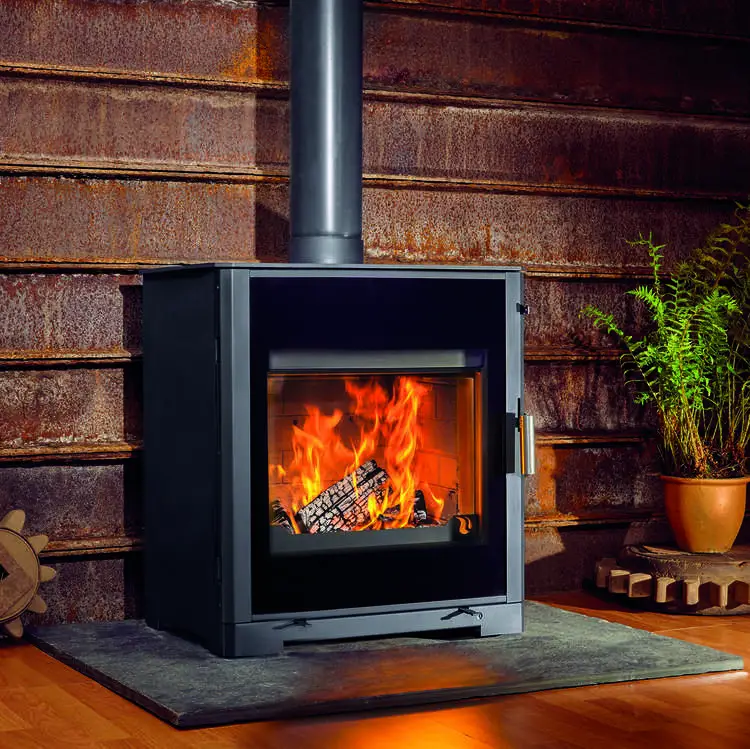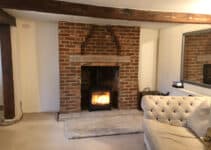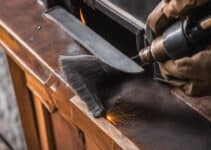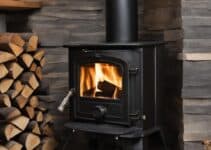If you’re thinking of taking your home off the energy grid, or are looking for a cheaper way to heat your property, you might be wondering, can a log burner heat water? A log burner can heat water, providing you have the correct infrastructure. You’d need a new water boiler and pipework to connect the system up. But this doesn’t have to be particularly difficult to set up, although it depends where in the house your log burner is.
In this article, we’ll look at how we can get a log burner to heat water (specifically for heating and mains water). Of course, if you want to boil water on a stove, just put a pan on top!

How Does a Log Burner Heat Water?
In simple terms, a log burner heats water through conduction, radiation, and possibly even convection.
Traditionally, log burners would have a back boiler, which, unsurprisingly, is a water tank connected to the back of the stove. If nothing else, the heat would radiate through the back of the stove into the tank.
Back boilers are still a perfectly acceptable system to use. More ‘modern’ back boilers have a gravity feed system that keeps the water moving; there’s a hot water output at the top and a cold water feed at the bottom.
Water runs through the back boiler and gets heated.
Log Burner with Back Boiler
A back boiler can provide both central heating and hot water for a home. Unlike an immersion heater, it heats water on demand, meaning it’s potentially unlimited but also that there’s a slight delay in the hot water reaching the tap.
However, as of 2005, back boilers have plummeted in popularity. One reason for this is that they were linked to numerous explosions. These happened due to incorrect installation and problems with pressure build-up.
Also, back boilers aren’t very efficient. They operate at a maximum of 70% efficiency because you lose 30% or more of the generated heat energy up the chimney.
When UK building regulations changed in 2005, condenser boilers became the norm, which began forcing back boilers out.

How Do You Get Hot Water From a Wood Burner?
Nowadays, we have much more efficient methods of getting hot water from a log burner. The easiest way to do it is via an indirect connection between the stove and the water tank.
In short, this means the wood burner heats up a coil that sits inside the water tank, which is basically an immersion heater.
Although it means you won’t have on-demand hot water, it’s slightly more efficient and does away with the risks associated with back boilers.
Another option is to have a system with a hot water thermal device fitted. These are basically incredibly well insulated water tanks that store heat energy until it’s needed.
They’re helpful in homes powered by renewable energy because you can link them to solar panels, wood pellet stoves, biomass burners, and more.
Even with advances in water heating and energy storage technology, there are still numerous considerations when connecting a wood burner to your home’s hot water supply. These include:
Vents
A wood burner heating system needs some kind of ventilation. This is so pressure can escape if needed, as even a standard central heating system has this function. Without it, things could explode.

Installation
Normal gas-powered boilers aren’t cheap, and a wood-burning heating system is even more expensive.
A thermal storage tank alone can be several thousand pounds, and you must also factor in new pipework to run from the stove to the tank and then to your plumbing.
Until recently, you could get Green Homes Grants to reduce the cost of installing this kind of infrastructure.
However, it only applied to biomass boilers rather than wood burners, as the former are a more efficient and eco-friendly option.
Environmental Impact
Is heating a home using a wood burner more eco-friendly than using natural gas? It depends on how you break down the factors and what you consider to be the most important determiner of eco-friendliness.
The most obvious place to start is with the fuel itself. Wood burners obviously burn wood.
This fuel source is carbon neutral because the trees draw in CO2 as they grow, and this is released back into the atmosphere when they’re burnt.
However, it’s slightly more complicated than that. The trees take in CO2 over their lifetime, which could be several decades.
When burnt, all that CO2 is released in one go. While it’s not ‘new’ CO2, to offset it, you’d need to plant enough trees at once to remove it from the atmosphere in one go.
That said, it’s still better than natural gas, which emits 490g of CO2 per kWh of energy produced. As this CO2 has been locked in the earth for millions of years, we consider it ‘new’ CO2 because it’s not currently part of the carbon cycle.
Another thing to consider are the other products created when burning the two fuels. Natural, seasoned wood is fairly clean, aside from some soot and other minor gases.
The big issue with wood is particulate matter, which can be harmful. Also, manually treated wood can contain all kinds of nasty chemicals that you don’t want to make airborne in your home.
Gas isn’t loads better though. However, an off-grid home with a gas storage tank can easily be converted to run on agricultural biogas.
It’s less harmful to the environment and is a drastically cheaper conversion than switching your water heating to a wood burner.
Will Water Boil on a Wood Stove?
Water will boil on a wood stove, providing there’s enough fuel in the stove and the water is given the right conditions to boil. This shouldn’t come as a surprise: any heat source that’s hot enough will boil water.
Although you could just put a pan of water near a wood burner and hope for the best, there are some ways to make the process more efficient.
For starters, use a cast iron stove or wood burner. Ideally, it should have a flat top, on which you can sit your pan of water. Cast iron is by far one of the best conductors of heat, once you light your log burner it’ll hold temperature for an incredibly long time.
Can you Boil a Kettle on a Log Burner?
You can boil a kettle on a log burner but you must use a cast iron kettle. It should be as enclosed as possible, just like an electric kettle. While an open pan of water will boil, it’s quicker and more energy efficient to put a lid on it.
Again, this shouldn’t come as a surprise if you’ve ever boiled a pan of water on a stove.
As for how long it takes, it could be 25 minutes at the very least. This is with a properly-maintained fire and enclosed kettle.
It takes a long time because, unlike an electric kettle, a stove can’t produce that much power. An electric kettle is 1500W, so can heat water in minutes.
A wood burner, however, produces somewhere around 40-50W, hence why it takes so long.
Water Kettle for Wood Stove
If you want to buy a specialised water kettle for your wood stove. I’d recommend this one:
The bottom line is that you can use a wood stove to boil water, but you better be patient! Don’t expect to have a cup of tea as quickly as normal because it just won’t happen.
Wood Burner Not Heating Water
If your wood burner isn’t heating water, there could be numerous reasons behind it. These are true for both pans of water on top and central heating systems powered by wood burners.
Some reasons include:
· Incorrectly built fire
· The stove doesn’t have sufficient draw
· The vents are too open or not open enough
· The fire is too small
· Your fuel is too wet, not properly seasoned, or isn’t burning properly
· The fire is too young (the burner isn’t hot enough)
·!– /wp:paragraph –>
· There’s too much ash in the pan
Most of these issues are easy to fix. Providing you maintain your stove, you shouldn’t have issues with too much ash or problems with the draw. Your stove should be cleaned regularly and the ash emptied daily.
Everything else is fairly easy to solve by building a proper fire within the stove. For example, the most efficient stage of wood burning doesn’t produce the most heat.
The most heat comes from fast-burning logs, but this is a waste of fuel.
This is why secondary combustion exists. It’s the process of burning off the gases created by burning wood, which increases the heat output of the stove.
Reaching this point depends on you increasing the temperature quickly with a properly built fire, which you then feed with larger logs.
Can you Boil Water on a Wood Stove
The bottom line is that it’s perfectly possible to heat a home’s water supply and boil water using a wood burner .
The specifics of your home will be unique, and there’s no guarantee that the whole process will be cheaper than whatever method you’re currently using.
Of course, because this deals with heat, gas, and energy, you’ll need to get a professional on board. Get some quotes from local engineers to get a better idea of what this system might cost you.




